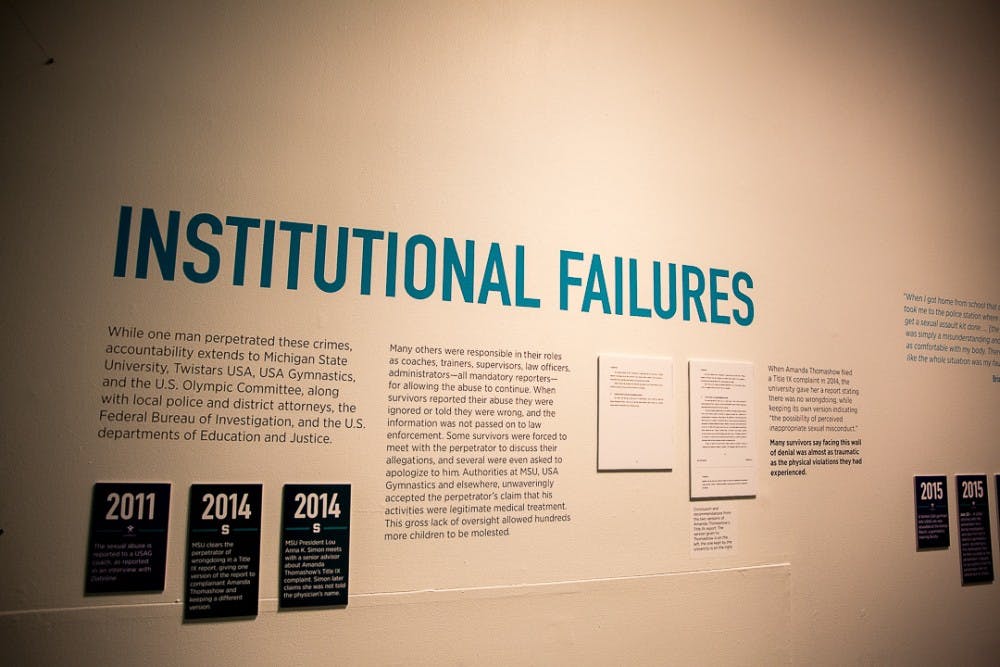When Larry Nassar was first publicly accused of sexually abusing his patients in 2016, Michigan State University’s worries immediately turned to a different case.
The one it handled back in 2014, when the famous sports doctor was cleared of sexual assault and allowed to continue his work for the university.
"Once the 2014 allegations come out, and my assessment is it will shortly, that sentiment will only intensify," MSU spokesperson Kent Cassella wrote in an email hours after the first public report of Nassar’s abuse. The "sentiment" he referenced was brewing speculation that MSU had allowed Nassar’s abuse to continue.
The 2014 allegations did come out, and they certainly fueled the idea that MSU played a role in Nassar’s ability to avoid consequence for so long. But, the university has long been able to aggressively downplay those claims.
Administrators have said that the allegations made in 2014 were less severe than those later made publicly because what was reported wasn’t inherently sexual. The investigator who handled the case has even been promoted in the years since.
But, long-secret documents are now revealing that behind closed doors, MSU had deep doubts: the university knew that crucial evidence was omitted, swaying the results in Nassar’s favor.
All the while, the survivor who reported Nassar was left with a decade of doubt and "self-hatred," wondering why they weren’t believed.
Survivor blamed themself
When Amanda Thomashow reported Nassar to MSU in 2014, they thought they told investigators that he had an erection as he groped them during an appointment, they told The State News.
The detail was essential to their allegation that Nassar had sexually assaulted them under the guise of medical treatment at his office on campus.
But, nothing about arousal made it into MSU’s final investigative report.
The omission supported the university’s determination that Nassar did not assault Thomashow, and that his groping was all part of legitimate medical treatment for their sports injuries.
After receiving the report, Thomashow questioned themself, wondering if they somehow forgot to mention his arousal to investigators, or didn’t make it clear enough.
It felt like a sort of "gaslighting," Thomashow said. The report clearing Nassar — and MSU’s subsequent denial that the university made mistakes in doing so — convinced Thomashow that they must have been wrong.
"It messes with your mind," they said. "(MSU) convinced me that I was crazy for letting the assault bother me so much."
They reached "a new level of self-hatred" in 2016, as hundreds of other survivors started coming forward with allegations against Nassar.
Thomashow became sure they were assaulted, but wondered if some of the other cases were their own fault, they said.
Many of the survivors coming forward were assaulted after 2014, after MSU cleared Nassar in Thomashow’s case. So, Thomashow began to worry that if they had just mentioned the erection, MSU would have sided against Nassar, fired him and the other survivors wouldn’t have been abused, they said.
New documents, however, suggest Thomashow did tell MSU’s investigators about the erection — they just mysteriously left it out of their report.
A crucial omission
In 2017, MSU conducted a sort of autopsy of Thomashow’s case: re-interviewing those involved and going through all investigator’s files.
Memos summarizing that autopsy greatly challenge the findings in the 2014 investigation. Some of them were among the thousands of long-privileged MSU documents recently released by Michigan’s attorney general. The State News obtained others from a person involved.
In the original notes from Thomashow’s interview, there are two references to Nassar being aroused, according to one of the memos.
The interview was conducted jointly by Kristine Moore, an MSU Title IX investigator, and Valerie O’Brien, an MSU Police captain.
"Enough to be little too much (in crotch)," they wrote in their notes, according to the autopsy.
They also noted that Thomashow said Nassar "went to corner of room 30-45 sec doing hand sanitizer. I thought weird — maybe erect."
Neither observation was mentioned in their final report.
The final report also made no mention of statements from Nassar’s department chair, Jeffrey Kovan. He told investigators it would not be appropriate or medically necessary to touch a patient inside of their underwear, the autopsy found. The report also didn’t include information about Nassar’s Facebook page getting banned "because of all the young girls," one memo said. It’s unclear exactly what that note refers to.
O’Brien has since left MSU Police. In 2020, she was demoted for making “inappropriate comments” and then was charged with drunk driving in 2021.
Moore was promoted in 2014, shortly after issuing Thomashow’s report. She now serves as an associate general counsel in the university’s legal office.
MSU declined to comment on the issues with the 2014 report. O’Brien could not be reached.
In the 2017 autopsy, O’Brien did offer a partial explanation of the omissions.
She said that Thomashow didn’t actually tell them Nassar was aroused. Instead, O’Brien said she and Moore added the various references to an erection into the notes after the interview was over. They were only "speculating," she said.
"(We) simply discussed whether that might have been the case," O’Brien said, according to the autopsy.
That defense was questioned by even the PR consultants MSU hired to design responses to the Nassar issue.
In a report prepared for administrators, consultants from Blue Moon Consulting Group wrote that the omission of the arousal notes could be disastrous for the university’s image. Because, as the consultants said, "Would that fact have changed not only the internal investigation but also the review of the local prosecutor?"
Thomashow said they never "got the sense" that anyone at MSU believed the university had truly mishandled their case. Instead, they were repeatedly told the outcome was their fault for not mentioning the erection.
"I asked over and over, why wasn’t I believed when (other survivors) were," they said. "The big difference was the erection, they said that was the difference."
"But they knew," Thomashow said.






